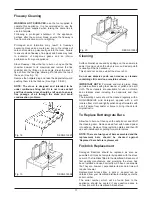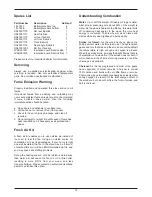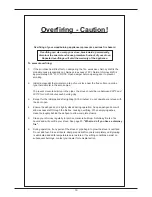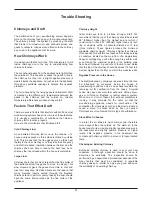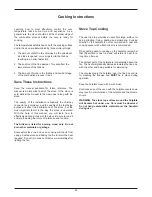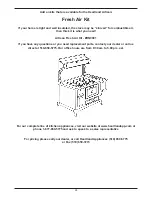
Top Oven Cooking
The oven door thermometer registers the temperature at
the door only. Oven temperatures vary from top to bottom
and side to side. The only accurate check on oven
temperature is an oven thermometer alongside food being
roasted or baked.
Once the stove has about 4” of red hot coals in the firebox,
it will become stable. The entire stove and the chimney
system is heated and running at a fairly constant
temperature. At this point, you may load a new charge of
wood following the instructions in the user manual.
The correct adjustment of the spinwheel to obtain the
oven temperature required varies with the chimney draft,
and can be found only by experiment. The following is a
suggested method only, and may need modification to suit
local conditions.
Suppose an oven temperature for roasting is desired, and
that the stove is idling:
Thoroughly de-ash the fire as described in the user
section, and re-fuel. Set the flue chamber damper to
halfway and open the spinwheel full. As soon as the fire
has become red all through, close the flue chamber
damper. Do not allow the fire to become white hot. The
temperature of the oven should now rise steadily. When it
reaches a point about 30°C (50°F) below that required,
close the spinwheel to approximately one turn open.
Thereafter control the temperature of the oven by
adjusting the spinwheel. When using the oven, best
results will be obtained by gradually modifiying the size of
the fire, and using only one or two logs at re-fuelling. Once
heated, a cast iron oven will lose heat very slowly. Fast
cooking on the hotplate will require a big fire.
The oven may be cleaned with a stiff wire brush, when it
is very hot. Do not touch the oven - wear oven mitts.
The adjustable flue chamber damper is for reducing the
chimney draft. The line markings on the flue chamber
enable the best settings to be repeated to suit the
chimney. These settings can be found only by
experimenting as every chimney set-up is different. Set
the flue chamber damper fully open after re-fuelling and
re-set to position that has been found by practical
experience to give the best results.
Oven Temperatures
Hot: 220-260°C (400-500°F)
Moderate: 150-200°C (300-400°F)
Slow: 90-150°C (200-300°F)
Bottom Oven Cooking
It is not possible to control this oven, but during the course
of roasting, sufficient heat input allows the simmering of
dishes that have been taken from the roasting oven.
Oven Temperatures
Hot: 135°C (275°F)
Moderate: 95°C (203°F)
During slow cooking periods, the bottom oven is ideal for
pre-heating plates and keeping food warm.
The temperatures outlined in this manual are for guideline
purposes only. The temperatures in the oven will vary in
accordance to the temperature in the firebox.
Ideally, the woodstove will perform best if it is left running
constantly, keeping the entire system warm. Depending
on the wood and chimney conditions it would typically take
three or four charges of cord wood to establish a good
base for oven cooking, meaning 1
1
/
2
to 2 hours before
cooking from a cold start.
Always load a new charge of wood to a glowing hot
coalbed - waiting too long to load a new charge results in
extreme temperature swings and will make cooking
difficult. The objective is to maintain the coal bed at a
constant heat. Occasional tending or stirring of the
coalbed may be required. Keeping these principles in
mind and with a little experience, cooking will be easy and
trouble-free.
Woodstove cooking methods are as diverse as their
owners - there is no right or wrong way, only, in time, your
way.
Remember by opening the flue damper there is less
resistance on the flue and a faster hotter fire will result.
The cooking surface directly over the firebox will typically
get hotter. Always open the flue damper before opening
the firebox door for re-fuelling. Wait momentarily before
opening the doors to allow smoke in the firebox to be
drawn up the chimney.
Maintain the stove properly. The benefits in superior
performance and safety are well worth the time.
27





